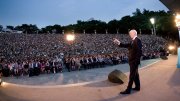The Lost Generation. The Greatest Generation. Generation X. And now…the App Generation.
“Are kids growing up in the digital age really different?” asks Howard Gardner, Hobbs professor of cognition and education. Six years ago, he and then-student Katie Davis, Ed.D. ’11 (now an assistant professor at the University of Washington) set out to explore the question, and in their new book, The App Generation: How Today’s Youth Navigate Identity, Intimacy, and Imagination in a Digital World (Yale), they argue that the answer is unambiguously yes.
“This is a generation that expects and wants to have applications,” says Gardner. Applications, more commonly known as apps, are shortcuts designed for accomplishing specific tasks. They’re ubiquitous, powerful, and strongly structured, and the authors argue that they’re changing the way we think. “Young people growing up in our time are not only immersed in apps,” they write, “they’ve come to think of the world as an ensemble of apps, to see their lives as a string of ordered apps, or perhaps, in many cases, a single, extended, cradle-to-grave app.”
The app mindset, they say, motivates youth to seek direct, quick, easy solutions—the kinds of answers an app would provide—and to shy away from questions, whether large or small, when there’s no “app for that.” In a wide-ranging cultural critique, the authors identify myriad resulting effects loosely structured around three of the stages of psychosocial development proposed by Gardner’s mentor Erik Erikson in 1950—here called identity, intimacy, and imagination.
They investigated the first two themes primarily through interviews with adolescents and focus groups of adults who work with teens. In terms of identity, Gardner and Davis argue that youth today are polished and packaged, in line with the cool, suave look of online profiles. In “Reflecting on Your Life” sessions with Harvard freshmen (see “The Most Important Course,” May-June 2011, page 56), Gardner writes, he encountered students “with their lives all mapped out—a super-app.” But the external polish often hides deep-seated anxiety, outwardly expressed as a need for approval. In their conversations with camp counselors and teachers, Gardner and Davis were repeatedly told that youth today are risk-averse; the app generation, said one focus group participant, is “scared to death.”
In exploring intimacy, Gardner and Davis saw repeated signs of greater isolation. Although social media can enhance friendships and family relationships, digital media can give the impression of closeness while promoting only shallow connections. Online relationships are often conducted at arm’s length, allowing youth to avoid the deeper emotional investment and vulnerability of more complicated, in-person relationships. (This emotional distance can also facilitate racist and sexist language that would be unacceptable in person.)
The book’s most unexpected results come from its study of imagination. Prompted by Gardner’s curiosity about how his high-school literary magazine might have changed in the 50 years since he was editor, the authors examined hundreds of samples of adolescent visual art and fiction between 1990 and 2010. Using a blind coding scheme to measure changes in topics such as subject, composition, and narrative flow, the authors concluded that graphic art has become more imaginative and diverse in the past 20 years, whereas creative writing has shown the opposite trend.
Though they acknowledged that all of their work is correlative, not causative, they speculated that the difference may reflect the emergence of online communities like deviantART and tools like Photoshop that increase amateur engagement with graphic media; in contrast, instant messaging and texting have largely supplanted more formal, written communications. The authors suggest that digital tools promote what they call “middle c” creativity, between the “little c” creativity of everyday problem-solving and the “Big C” of groundbreaking achievements. Though software may lower the bar for creative engagement, they write, users may never move beyond the tools’ inherent limitations.
“When do things that are optional become blinkers on how we see the world?” asks Gardner. He and Davis argue that people can be app-enabled, using apps as tools to eliminate tedious tasks and catalyze new forms of exploration, or app-dependent, relying heavily on the available tools as a substitute for skill and reflection. And the authors argue that automation itself is a dual-edged sword. “Who decides what is important?” they write. “And where do we draw the line between an operation”—using a GPS to navigate to Boston’s North End, for instance—“and the content on which the operation is carried out?”—orienting oneself in the city. Gardner points out that many of today’s teens have never been lost, either literally or metaphorically, and that many don’t even see the point of a “random walk,” an experience that he argues can build independence and resilience.
Apps are here to stay, the authors make clear, and the question now is how to make use of them in a productive, creative way. As an educator, Gardner favors what he calls a “constructivist” approach to learning—in which knowledge is acquired through exploration—and he believes that apps, by shortcutting discovery, can diminish this engagement with the world. Before downloading an app, he says, people should ask themselves what they would do without it: if they had to obtain directions or contact a friend, for instance, without a smartphone. “Even though a well-demonstrated toy or well-designed app has its virtues,” he and Davis write, “there is also virtue—and even reward—in figuring out things for yourself on your own time, in your own way.”









